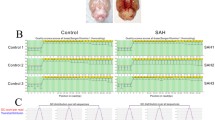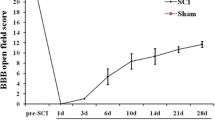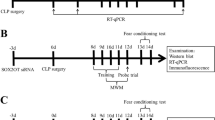Abstract
Sepsis-associated encephalopathy (SAE) is related to cognitive sequelae in patients in the intensive care unit and can have serious impacts on quality of life after recovery. Although various pathogenic pathways are involved in SAE development, little is known concerning the global role of long non-coding RNAs (lncRNAs) in SAE. Herein, we employed transcriptome sequencing approaches to characterize the effects of lipopolysaccharide (LPS) on lncRNA expression patterns in brain tissue isolated from Sprague–Dawley rats with and without SAE. We performed high-throughput transcriptome sequencing after LPS was intraperitoneally injected and predicted targets and functions using bioinformatics tools. Subsequently, we explored the results in detail according to Gene Ontology (GO) and Kyoto Encyclopedia of Genes and Genomes (KEGG) analyses. LncRNAs were differentially expressed in brain tissue after LPS treatment. After 6 h of LPS exposure, expression of 400 lncRNAs were significantly changed, including an increase in 316 lncRNAs and a decrease in 84 lncRNAs. In addition, 155 mRNAs were differentially expressed, with 84 up-regulated and 71 down-regulated. At 24 h post-treatment, expression of 117 lncRNAs and 57 mRNAs was consistently elevated, while expression of 79 lncRNAs and 21 mRNAs was decreased (change >1.5-fold; p <0.05). We demonstrated for the first time that differentially expressed lncRNAs were predicted to be enriched in a post-chaperonin tubulin folding pathway (GO: 007023), which is closely related to the key step in the tubulin folding process. Interestingly, the predicted pathway (KEGG 04360: axon guidance) was significantly changed under the same conditions. These results reveal that LPS might influence the construction and polarization of microtubules, which exert predominant roles in synaptogenesis and related biofunctions in the rodent central nervous system (CNS). An inventory of LPS-modulated expression profiles from the rodent CNS is an important step toward understanding the function of mRNAs, including lncRNAs, and suggests that microtubule malformation and dysfunction may be involved in SAE pathogenesis.






Similar content being viewed by others
Abbreviations
- CLP:
-
Caecal ligation and puncture
- CNS:
-
Central nervous system
- FDR:
-
False discovery rate
- GO:
-
Gene Ontology
- ICU:
-
Intensive care unit
- KEGG:
-
Kyoto encyclopedia of genes and genomes
- LPS:
-
Lipopolysaccharide
- lncRNAs:
-
Long non-coding RNAs
- NT:
-
Nucleotides
- RPKM:
-
Reads per kilobase per million mapped reads
- SAE:
-
Sepsis-associated encephalopathy
References
Widmann CN, Heneka MT (2014) Long-term cerebral consequences of sepsis. Lancet Neurol 13:630–636
Zhang J, Yuan L, Zhang X, Hamblin MH, Zhu T, Meng F et al (2016) Altered long non-coding RNA transcriptomic profiles in brain microvascular endothelium after cerebral ischemia. Exp Neurol 277:162–170
Yin D, He X, Zhang E, Kong R, De W, Zhang Z (2014) Long noncoding RNA GAS5 affects cell proliferation and predicts a poor prognosis in patients with colorectal cancer. Med Oncol 31:253
Hangauer MJ, Vaughn IW, McManus MT (2013) Pervasive transcription of the human genome produces thousands of previously unidentified long intergenic noncoding RNAs. PLoS Genet 9:e1003569
van Bakel H, Nislow C, Blencowe BJ, Hughes TR (2010) Most “dark matter” transcripts are associated with known genes. PLoS Biol 8:e1000371
Struhl K (2007) Transcriptional noise and the fidelity of initiation by RNA polymerase II. Nat Struct Mol Biol 14:103–105
Lin J, Zhang X, Xue C, Zhang H, Shashaty MG, Gosai SJ, et al. (2015) The long noncoding RNA landscape in hypoxic and inflammatory renal epithelial injury. Am J Physiol Renal Physiol. 309:F901–F913
Wang KC, Chang HY (2011) Molecular mechanisms of long noncoding RNAs. Mol Cell 43:904–914
Geisler S, Coller J (2013) RNA in unexpected places: long non-coding RNA functions in diverse cellular contexts. Nat Rev Mol Cell Biol 14:699–712
Spadaro PA, Bredy TW (2012) Emerging role of non-coding RNA in neural plasticity, cognitive function, and neuropsychiatric disorders. Front Genet 3:132
Ponjavic J, Oliver PL, Lunter G, Ponting CP (2009) Genomic and transcriptional co-localization of protein-coding and long non-coding RNA pairs in the developing brain. PLoS Genet 5:e1000617
Qureshi IA, Mattick JS, Mehler MF (2010) Long non-coding RNAs in nervous system function and disease. Brain Res 1338:20–35
Faghihi MA, Zhang M, Huang J, Modarresi F, Van der Brug MP, Nalls MA et al (2010) Evidence for natural antisense transcript-mediated inhibition of microRNA function. Genome Biol 11:R56
Roberts TC, Morris KV, Wood MJ (2014) The role of long non-coding RNAs in neurodevelopment, brain function and neurological disease. Philos Trans R Soc Lond B Biol Sci 369:20130507
Chen R, Liu L, Xiao M, Wang F, Lin X (2016) Microarray expression profile analysis of long noncoding RNAs in premature brain injury: a novel point of view. Neuroscience 319:123–133
Buras JA, Holzmann B, Sitkovsky M (2005) Animal models of sepsis: setting the stage. Nat Rev Drug Discov 4:854–865
Freise H, Bruckner UB, Spiegel HU (2001) Animal models of sepsis. J Invest Surg 14:195–212
Remick DG, Ward PA (2005) Evaluation of endotoxin models for the study of sepsis. Shock 24(Suppl 1):7–11
Dyson A, Singer M (2009) Animal models of sepsis: why does preclinical efficacy fail to translate to the clinical setting? Crit Care Med 37:S30–S37
van der Poll T (2012) Preclinical sepsis models. Surg Infect (Larchmt) 13:287–292
Qureshi IA, Mehler MF (2013) Long non-coding RNAs: novel targets for nervous system disease diagnosis and therapy. Neurother 10:632–646
Liu SJ, Nowakowski TJ, Pollen AA, Lui JH, Horlbeck MA, Attenello FJ et al (2016) Single-cell analysis of long non-coding RNAs in the developing human neocortex. Genome Biol 17:67
Mercer TR, Dinger ME, Sunkin SM, Mehler MF, Mattick JS (2008) Specific expression of long noncoding RNAs in the mouse brain. Proc Natl Acad Sci USA 105:716–721
NE II, Heward JA, Roux B, Tsitsiou E, Fenwick PS, Lenzi L et al (2014) Long non-coding RNAs and enhancer RNAs regulate the lipopolysaccharide-induced inflammatory response in human monocytes. Nat Commun 5:3979
Ng SY, Bogu GK, Soh BS, Stanton LW (2013) The long noncoding RNA RMST interacts with SOX2 to regulate neurogenesis. Mol Cell 51:349–359
Ng SY, Lin L, Soh BS, Stanton LW (2013) Long noncoding RNAs in development and disease of the central nervous system. Trends Genet 29:461–468
Zhou X, Xu J (2015) Identification of Alzheimer’s disease-associated long noncoding RNAs. Neurobiol Aging 36:2925–2931
Voelzmann A, Hahn I, Pearce SP, Sanchez-Soriano N, Prokop A (2016) A conceptual view at microtubule plus end dynamics in neuronal axons. Brain Res Bull 126:226–237
Penazzi L, Bakota L, Brandt R (2016) Microtubule dynamics in neuronal development, plasticity, and neurodegeneration. Int Rev Cell Mol Biol 321:89–169
Breviario D, Giani S, Morello L (2013) Multiple tubulins: evolutionary aspects and biological implications. Plant J 75:202–218
Westermann S, Weber K (2003) Post-translational modifications regulate microtubule function. Nat Rev Mol Cell Biol 4:938–947
Beaven R, Dzhindzhev NS, Qu Y, Hahn I, Dajas-Bailador F, Ohkura H et al (2015) Drosophila CLIP-190 and mammalian CLIP-170 display reduced microtubule plus end association in the nervous system. Mol Biol Cell 26:1491–1508
Prokop A, Beaven R, Qu Y, Sanchez-Soriano N (2013) Using fly genetics to dissect the cytoskeletal machinery of neurons during axonal growth and maintenance. J Cell Sci 126:2331–2341
Twelvetrees A, Hendricks AG, Holzbaur EL (2012) SnapShot: axonal transport. Cell 149:950
Baas PW, Lin S (2011) Hooks and comets: the story of microtubule polarity orientation in the neuron. Dev Neurobiol 71:403–418
Risco C, Pinto da Silva P (1995) Cellular functions during activation and damage by pathogens: immunogold studies of the interaction of bacterial endotoxins with target cells. Microsc Res Tech 31:141–158
Russwurm S, Bohm KJ, Muhlig P, Wiederhold M, Konig K, Reinhart K (2000) Lipopolysaccharide induces distinct alterations in the microtubule cytoskeleton of monocytes. Cell Biol Toxicol 16:339–346
Bohm KJ, Vater W, Russwurm S, Reinhart K, Unger E (1998) Lipopolysaccharide-caused fragmentation of individual microtubules in vitro observed by video-enhanced differential interference contrast microscopy. FEBS Lett 425:134–136
Wilson PG, Borisy GG (1997) Evolution of the multi-tubulin hypothesis. Bioessays 19:451–454
Lewis SA, Tian G, Cowan NJ (1997) The alpha- and beta-tubulin folding pathways. Trends Cell Biol 7:479–484
Lopez-Fanarraga M, Avila J, Guasch A, Coll M, Zabala JC (2001) Review: postchaperonin tubulin folding cofactors and their role in microtubule dynamics. J Struct Biol 135:219–229
Garcia-Mayoral MF, Castano R, Fanarraga ML, Zabala JC, Rico M, Bruix M (2011) The solution structure of the N-terminal domain of human tubulin binding cofactor C reveals a platform for tubulin interaction. PLoS One 6:e25912
Bhamidipati A, Lewis SA, Cowan NJ (2000) ADP ribosylation factor-like protein 2 (Arl2) regulates the interaction of tubulin-folding cofactor D with native tubulin. J Cell Biol 149:1087–1096
Prokop A (2013) The intricate relationship between microtubules and their associated motor proteins during axon growth and maintenance. Neural Dev 8:17
Kim J, Martignetti JA, Shen MR, Brosius J, Deininger P (1994) Rodent BC1 RNA gene as a master gene for ID element amplification. Proc Natl Acad Sci USA 91:3607–3611
DeChiara TM, Brosius J (1987) Neural BC1 RNA: cDNA clones reveal nonrepetitive sequence content. Proc Natl Acad Sci USA 84:2624–2628
Sosinska P, Mikula-Pietrasik J, Ksiazek K (2015) The double-edged sword of long non-coding RNA: the role of human brain-specific BC200 RNA in translational control, neurodegenerative diseases, and cancer. Mutat Res Rev Mutat Res 766:58–67
Tiedge H, Chen W, Brosius J (1993) Primary structure, neural-specific expression, and dendritic location of human BC200 RNA. J Neurosci 13:2382–2390
Cristofanilli M, Iacoangeli A, Muslimov IA, Tiedge H (2006) Neuronal BC1 RNA: microtubule-dependent dendritic delivery. J Mol Biol 356:1118–1123
Wang H, Iacoangeli A, Lin D, Williams K, Denman RB, Hellen CU et al (2005) Dendritic BC1 RNA in translational control mechanisms. J Cell Biol 171:811–821
Martin KC, Zukin RS (2006) RNA trafficking and local protein synthesis in dendrites: an overview. J Neurosci 26:7131–7134
Lewejohann L, Skryabin BV, Sachser N, Prehn C, Heiduschka P, Thanos S et al (2004) Role of a neuronal small non-messenger RNA: behavioural alterations in BC1 RNA-deleted mice. Behav Brain Res 154:273–289
Liu G, Dwyer T (2014) Microtubule dynamics in axon guidance. Neurosci Bull 30:569–583
Wadsworth WG (2015) Understanding axon guidance: attraction, repulsion, and statistical physics. Neural Regen Res 10:176–179
Funding
Funding for this project was provided by the Natural Science Foundation of China (Grant Number: 81071530).
Author Contributions
WS was a major contributor in manuscript writing and data analysis. LP gave an important direction for study design. ZL participated in animal care and RNA extraction. All authors read and approved the final manuscript.
Author information
Authors and Affiliations
Corresponding author
Ethics declarations
Conflict of interests
The authors report no conflict of interests.
Rights and permissions
About this article
Cite this article
Sun, W., Pei, L. & Liang, Z. mRNA and Long Non-coding RNA Expression Profiles in Rats Reveal Inflammatory Features in Sepsis-Associated Encephalopathy. Neurochem Res 42, 3199–3219 (2017). https://doi.org/10.1007/s11064-017-2357-y
Received:
Revised:
Accepted:
Published:
Issue Date:
DOI: https://doi.org/10.1007/s11064-017-2357-y




